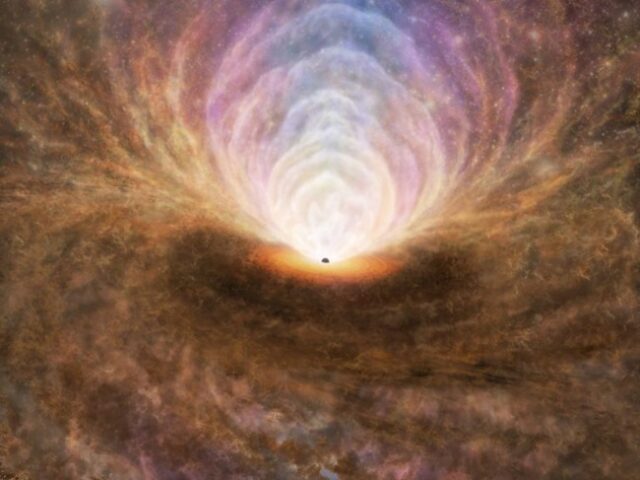An international research team led by Assistant Professor Takuma Izumi of the National Astronomical Observatory of Japan is using ALMA to study the Compass galaxy, which is relatively close to Earth at a distance of about 1400 million light years, at a distance of about 1 light year. We observed the flow of all gas phases, including plasma, atoms, and molecules, around a supermassive black hole with a mass 200 million times that of the sun.

The center of the Compass galaxy observed with ALMA
Image source: ALMA (ESO/NAOJ/NRAO), T. Izumi et al.
A monumental achievement in the history of supermassive black hole research
In order to quantitatively understand the growth of black holes, it is necessary to measure the flow rate of the accretion flow (how much gas is flowing in), and what type of gas (plasma gas, atomic gas, etc.) is used as the ejected flow. It is necessary to measure the amount of gas (molecular gas) flowing out, but observational understanding of this has not progressed.In this research, an international research team led by Assistant Professor Takuma Izumi of the National Astronomical Observatory of Japan used ALMA to investigate gas flows and their structure on an extremely small spatial scale of just a few light years around a supermassive black hole. For the first time in the world, we succeeded in quantitatively measuring all phases of plasma, atoms, and molecules.
In addition, most of the black hole accretion flow at the galactic center on a one-light-year scale is not used for black hole growth; it is ejected from the vicinity of the black hole as atomic or molecular gas, then returns to the gas disk and returns to the black hole. It was also found that a gas circulation occurs like a fountain, turning into an accretion flow.
Assistant Professor Takuma Izumi of the National Astronomical Observatory of Japan, who led this research, stated the importance of this research, saying, ``I believe this research is a monumental achievement in the history of supermassive black hole research.''In the future, the research team aims to investigate supermassive black holes that are located further away and have a variety of properties, and will not only conduct observations using the ALMA telescope, but also use next-generation large-scale radio interferometers that are currently being planned. We have high hopes for the observations made by the astronomers.

An imaginary diagram of the interstellar medium distribution of active galactic nuclei based on this observation result
Image source: ALMA (ESO/NAOJ/NRAO), T. Izumi et al.
■ALMA telescope
ALMA (Atacama Large Millimeter/Submillimeter Interferometer) uses a mechanism called an "interferometer," in which many small telescopes are arranged over a large area and linked together to function as one gigantic telescope. By combining a total of 1 parabolic antennas, 12 parabolic antennas with a diameter of 54 meters and 7 parabolic antennas with a diameter of 12 meters, one gigantic radio telescope is created.Japan's cutting-edge technology has been generously introduced, and it has a high resolution equivalent to 66 visual acuity and a high sensitivity 1 times higher than conventional radio telescopes.
■Next generation large radio interferometer
The next generation Very Large Array project is a next generation radio telescope project that aims to create a radio telescope with an aperture of up to 200 kilometers by installing more than 8,860 antennas distributed throughout North America. .
Paper information:
[Science]Supermassive black hole feeding and feedback observed on subparsec scales
Research presenter:
National Astronomical Observatory of Japan ALMA Project Assistant Professor Takuma Izumi
Professor Keiichi Wada, Graduate School of Science and Engineering, Kagoshima University
Professor Kotaro Kono, Graduate School of Science, The University of Tokyo
Professor Yutaka Fujita, Graduate School of Science, Tokyo Metropolitan University
Taiki Kawamuro, Special Researcher in Basic Science, RIKEN Pioneering Research Headquarters
Naoki Matsumoto, master's student at Tohoku University Graduate School of Science
Joint presenting organization:
National Astronomical Observatory of Japan, National Institutes of Natural Sciences
Kagoshima University
Tokyo Metropolitan University
Tokyo University
RIKEN
Tohoku University
University where you can study space
For information on universities where you can study space, you can check out university information and experiences of going to university on the website ``Sorato''.
https://www.solato.net/solawomanabu/
